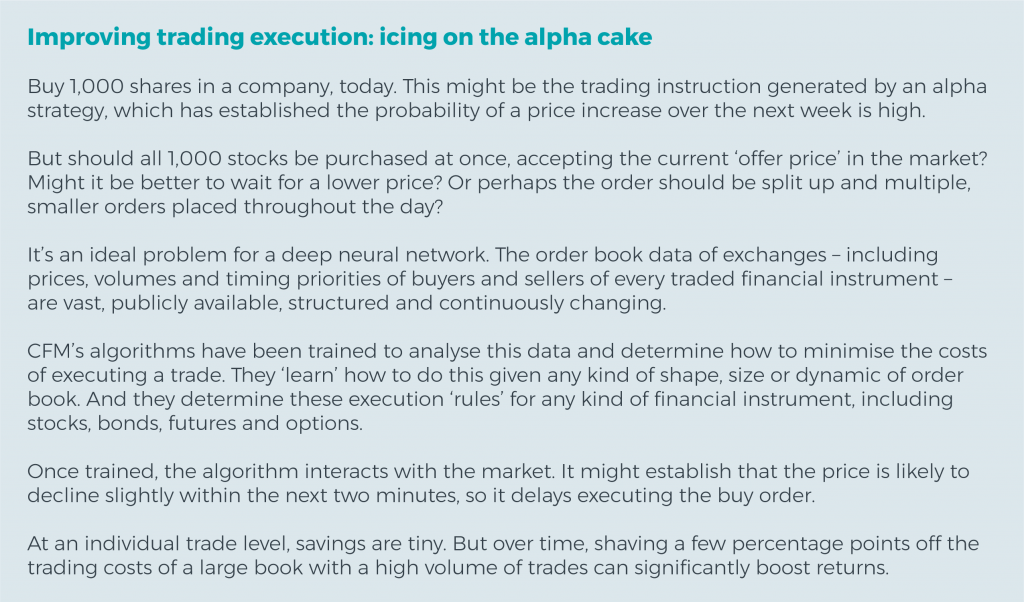This article was originally published in Institutional Investor on 31 October 2018. See the original article here.
It’s the people, not the computing, says Laurent Laloux, Chief Product Officer at CFM.
Artificial intelligence (AI) is a powerful tool for asset managers, especially quant funds. But there are few quick wins. Investment in people and infrastructure, research, and patience, are all required to outperform the market.
Armed with many new data sources, as well as cheap and increased computing power and data storage facilities, scientists have been able to advance the primary AI techniques in use today – neural networks, support vector machines, and random forests – and their applications, very rapidly over the last few years.
Their use and sophistication have also increased because many developers have made the tools used to build them available as open source software. As a result, organizations can test AI techniques in real world situations without developing their own algorithms from scratch.
Deep neural networks, which fall into the machine learning subset of AI, have recently produced impressive results and found widespread application: playing classic board games, image recognition, natural language processing, and, of particular relevance to asset management, making predictions from data.
Like a human brain, deep neural networks learn by practice and feedback, not by processing a long set of handcrafted rules. This makes it a powerful tool in asset management. When market characteristics change, a neural network can adjust its calculations accordingly.

Previously impossible analyses
In the fundamental research function of asset management, AI powered tools can now be deployed to conduct analyses that were previously impossible to do. Algorithms can scan the web; read and interpret millions of documents and audio clips; recognize sentiment in text or voice; and even identify “noisy” activity levels that might indicate an area requiring further research, such as a spike in discussions, patents, or academic papers about a new technology.
Then they need to provide this feedback to research analysts.
Machines, even AI-powered machines, are essentially very efficient tools for doing one thing, and are nowhere near replacing humans for many higher-level functions. They are also not going to start a project on their own – at least not in the near future – so, in many areas of asset management, humans are and will for some time to come still be needed to initiate, guide, and provide context to the work performed by machines.
An edge for quants, but difficult to capture
For quantitative investment managers, techniques such as deep neural networks are an addition to the existing quantitative investing toolkit. At CFM, all quantitative techniques, whether they use AI or not, are applied in some combination to generate alpha. They can also be very effective to reduce the cost of trading, as noted in the above sidebar.
It is now technically and economically feasible to analyze vast amounts of data that might impact the future price of a financial instrument, including:
► Pricing data at a very granular level from exchanges all over the world
► Fundamental data, such as financial results, sector and macroeconomic trends
► “Exotic” data, such as investor sentiment derived from social media, the state of crops derived from satellite images,
or usage trends of electronic devices derived from the Internet of Things
It is an extremely complicated task to implement these techniques to predict prices, and thus there are few quick wins. CFM’s researchers and data scientists are constantly fishing in new data sets and testing new techniques, which quite often produce only incremental improvements to the alpha strategy. For example, from a data set of approximately 1.5 million daily financial “stories” generated – ranging from concise tweets to in-depth articles – only about 100 would have a discernable impact on prices and would be worth incorporating into a trading algorithm. But the algorithms do uncover many needles in the data haystack.